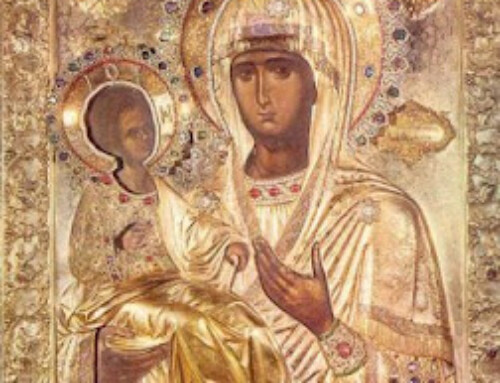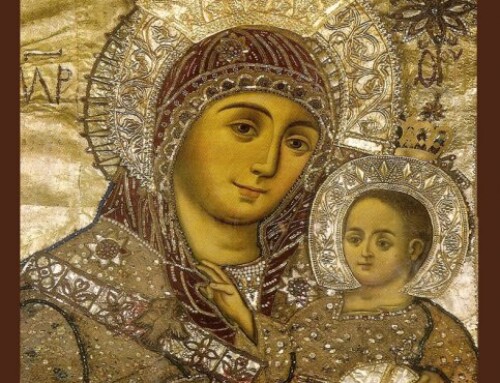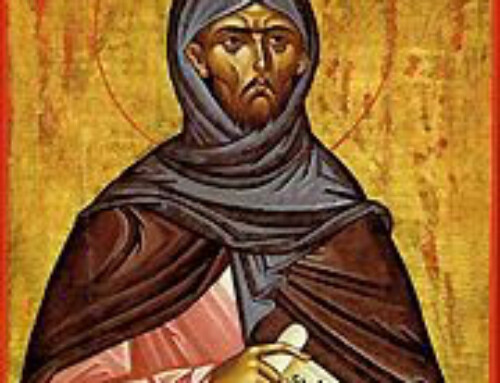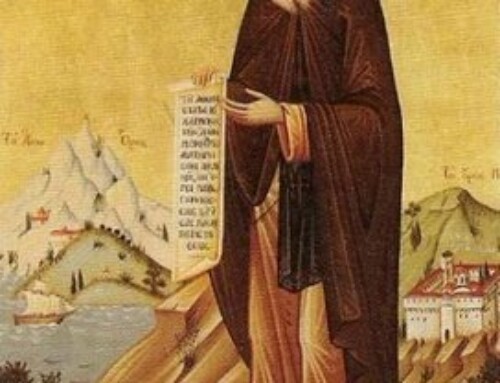The Word Magazine March 1986 Page 12-14
John Chrysostom:
His Message For Us
By Father Joseph Allen
Vicar- General of the Archdiocese
Our father among the saints, John Chrysostom, is a name which most of us know because that name is attached to the Eucharistic Liturgy which we most often celebrate in our Church. Beyond this, however, his figure stands as one of tremendous prominence in the whole of Christendom, both East and West. As is usual in such cases, it is what we do not know of such persons, which is the real substance of that prominence. For John Chrysostom, John “the Golden Mouthed” — his life is tremendously interesting, his works voluminous.
His Life.
For our present purposes we can say this about his life. He was born in the year 347 at Antioch, which was then the capital of Syria. His father was a distinguished military officer (magister militum) in the imperial army of Syria. His mother, Anthusa, was a pious Christian who was widowed at the age of twenty, and who thereafter devoted herself to raising her son John and his older sister. 1 John’s earliest inclination was to the monastic life, but it was upon the wish of his mother that he delayed entering that life. He, himself, records this incident. His mother took him into her chamber and begged him with tears not to forsake her, since he was her only comfort since his father’s death: “Do not plunge me into a second widowhood; nor revive the grief which is now laid to rest; wait for my death: it may be in a little while that I shall depart.” He did wait, but it was soon thereafter that John entered the monastery in the mountains south of Antioch.2
Because of ill-health, however, he had to return to the city and was immediately ordained to the diaconate and priesthood. Antioch provided the needed lesson for Chrysostom; it was both a vineyard of the Lord and the “school room” and “hospital” where he became acquainted with the care for the poor and the sick, with the avarice and vices of his own congregation, with the excesses of the circus and theater, and with a radically mixed population of Christians, Jews and heathens. Indeed, being one of the great capitals of the Empire, along with Alexandria, Rome and Constantinople, Antioch was a delightful residence to draw such a mixed population: it had an abundance of pure water from the Orontes, fertile land, commerce of the sea, and an imposing architecture of Middle Eastern, Greek and Roman styles. Its main street was four miles long, very broad, paved with red granite, and illuminated by innumerable lanterns placed upon spacious colonnades. Its population, we learn from Chrysostom himself, was about 200,000, only half of which were Christians. Here is where Chrysostom learned, and preached and ministered. He spent seventeen years as a presbyter (priest) in this city before he was led by military escort, against his will, to be consecrated (actually by Theophilus, Patriarch of Alexandria, and at the insistence of the Emperor Arcadius), the Archbishop of Constantinople in 398. Most of all that we have which the great saint wrote and taught, however, was from this 17-year period in Antioch.
Like any priest today, his problems at that time were those related to the pastoral ministry: he preached on the obligations and responsibilities of his flock, and felt the same frustrations as those in the contemporary priesthood. For example, he would preach against the theatres and chariot races, and yet as soon as he would finish his sermon, his parishioners would quickly run off to the circus to witness these same exciting spectacles. He complained that the people talked too much in church, that they were not praying as they should, that they were too often day-dreaming, with their eyes and attention roaming “all over the place.” One particular time he complained that the people did not have patience with the length of the service; it was too long for them.
But when Chrysostom preached, the church was packed; indeed, he had to warn his listeners to beware of the pickpockets who found such a large gathering to be an inviting harvest. Some of these homilies were published by himself, but most of them were taken down by shorthand (“fast writing”). In such days the preacher was seated, the people were standing’ Also at such times, the people were so enthused and spell-bound by what he said that they would actually begin to applaud. Chrysostom would then rebuke them for this applause, but they, in turn, would only applaud his rebuke!
These, and much more, give us a glimpse into the life of St. John while he was active as a priest and pastor in Antioch. It can only be added that, in a sense, it is a paradox to say that we remember this great pastor as the Archbishop of Constantinople. I say this because, after all, Chrysostom remained active as a bishop in Constantinople for only about five or six years, while he was a pastor for seventeen years at Antioch, and since most of what we have of him is from that time of Antioch, it seems that he should be commemorated as the “presbyter of Antioch,” rather than “Archbishop of Constantinople”. 3 Of course, one can suppose the only answer here is that every hierarch must also be a true pastor.
Chrysostom’s life ended during his second banishment in Pontos in his sixtieth year of life. He died in exile due to his various conflicts with the Empress Eudoxia on September 14, 407. After receiving the Holy Eucharist and commending his soul to God, he died with his own famous doxology: “Glory to God for all things”.
His Works.
St. John Chrysostom has been labeled with the greatest of complimentary names, but there is one among them, given by F.W. Farrar in his History of Interpretation which best describes his works. Farrar called him, “the ablest of Christian homilists and one of the best Christian men, the bright and consummate flower of the school of Antioch”.4
After receiving his literary training from Libanius, a non-Christian (from whom he learned the Greek classics and law), and after being baptized in his mid-twenties, Chrysostom studied under Diodorus of Tarsus. It was Diodorus who is considered to be the actual founder of the Antiochian school of theology, but it is Chrysostom and his fellow student, Theodore Mopsuestia, who are the best representatives of this school. 5 The Alexandrian school, its counterpart, was much more neo-platonic, and was strongly influenced by the teachings of both Plotinus and Origen. Its anthropology — and therefore its theology — was thus much more metaphysical, speculative and abstract.6 The Antiochian school, on the other hand, was based much more on historical, grammatical and human interpretation of theology. This difference between these two schools in its most theoretical forms, was finally seen in their respective Christologies and exegeses (or interpretation of the Scriptures). But, in terms of the impact of each of these schools of thought, this quite naturally had its effect upon their instruction and guidance of the people, i.e. upon their education, sociology and anthropology. As we learn from Chrysostom, as well as Mopsuestia, (who do best represent this school of thought), it is the manhood of God which calls forth the potential godliness of man; in this approach they were solidly rooted. Before one can speak of Theosis, one must first speak of Sarkosis; before one can speak of the “godlikeness of man,” he must speak of the “enfleshment of God.” For the Antiochian school, one interprets the scripture, and then, applies it to life, coming out of that base. Chrysostom, then, was no neo-mystic, no neo-platonist, no neo-militant, but he certainly touched the heights of mysticism, knew Greek philosophy very well, and confronted — quite militantly — the governmental powers of the day.
Philip Schaff would finally say of this Antiochian approach, seen now through Chrysostom’s ministry:
He preached morals rather than dogma, Christianity rather than theology; active, practical Christianity that proves itself in holy living and dying. He was a martyr of the pulpit, for it was chiefly his faithful preaching that caused his exile . . . in him was the fulness of scriptural knowledge…. the fruitfulness of illustration and application, the variation of topics…and the magnetism of sympathy and tender affection. 7
Chrysostom for Today.
Since his works are voluminous, since what he wrote, how he preached, what he did among the people, are of such a great scope, what can we today take from this great father?8 Out of all that, what can we say? If we could but take the vapor of his presence, the aroma of his thought, the essential crystallization of his ministry, it would be realized in one word: life.
Indeed, he focused on such wide subjects as the priesthood and the “rational flock” (laity), on patience and anger, on wealth and poverty, on peace and suffering, on integrity, wisdom, faith, hope and love. But, for Chrysostom, these were always seen in the human context, on the human face as it meets the face of God — precisely in life! This is not merely life as existence, but “abundant” life, or to use the Pauline formula, “life in Christ.” For us today, under Chrysostom’s teaching, we would have to immediately add “prayer,” for he would say that life is prayer, and to live is to pray, if we mean by prayer “stepping into the presence of God”. For him, prayer is properly called the spirituality of life, or the “direction of life,” for spirituality has to do, precisely, with how we direct our life.
One can say this because if one is at all to speak of the “holy,” if one is to concern himself at all with “abundance,” then one must speak of prayer, and to speak of prayer is to begin with life. Chrysostom would say this, and I would like to explain how I imagine he would speak to us of this relationship of life and prayer. First, I would speculate that, as he spoke to us about life and prayer, he would be solidly transparent of our Lord Jesus Christ. It is clear in the Gospels (especially in the Synoptic Gospels) that when Our Lord speaks about spirituality, about the “Kingdom,” he speaks about seeds, and clouds, and coins, and sheep. In all his parables about the Kingdom, God as a person is not mentioned one time. Rather He is to be seen en-fleshed in human life, tucked into the dynamics of our world and its life, that is, in the stories of finding and selling and buying, of pearls, of an importune widow, of a prodigal son, of the southern wind. God’s presence is always, always reflected in the images of life.
In essence what this finally comes to mean is that if one can live, one can pray. If we have more potential for life, we have more potential for prayer. The power to live, therefore, is already the sign to us that we have the power to pray. If, in this life, one can have compassion, if one can laugh and cry, if one can dance and sing, if one can sit and look at — and allow yourself to be looked at — one is already at the first step into this prayer. This is true because one does not have a dead center; we have a center that is the source for life. Life in God is lived with some radiance, instead of a dead, lusterless feature. Chrysostom would say “look into yourself and see there life at the center.” Then you will know prayer!
The second thing he would say would be something about our communal life. For us this morning (at this Liturgy), he would perhaps say that you must have a great potential for life, because you got here, at what he called the “synaxis” of the Liturgy. You had to “overcome” the power of death today because you are here; anybody who got up this morning has “overcome.” Chrysostom would be this concrete and would use this kind of illustration from our present circumstance. He would say that this is a real clue to us about the nature of our prayer: to discover what our communal prayer is about we must again discover what life is about. After you have slept all night, when you start “coming-to” — with whatever degree that might be for you in the morning — and when you finally reach that moment when you say “I shall arise”, (even though your body says “that’s what you think!”) the life-death struggle, in a sense, is on! This is how real Chrysostom would see it; our struggle (our akesis) is right there. The life-death struggle that is on, when you begin to assert yourself out of the gravity of that sleeping position, has something to say to you, is an analogy about the life-death struggle in the general way we Christians live; in the living out of a scriptural virtue, in the birth of a child, in the words we speak — or do not speak — to each other, in the refusal to spiritually grow — all of it could be seen in terms of the life-death struggle in the Christian life. This is how Chrysostom might speak to us about the paschal mystery, the dying and rising of Christ, as it is seen and understood in our own human life death struggle.
All this might also mean what St. John would call our “power” (what the scripture calls our dynamis, our exosia), that which
has been given to us by God, precisely, to live: is it possible for me spiritually, to live more fully, to go through the day more alive than dead, to be more of a blessing than a curse? Now you may think that that sounds deceptively simple, but St. John could carry this important message in this very simple illustration. For example, I do not know about you, but I recognize life very often when I see it; don’t you? Kids know if teachers are dead or alive; husbands & wives know if their spouse is dead or alive; the worshipping community knows if the celebrating priest is dead or alive; the listening parishioner knows if the preacher is dead or alive. It gets through! And if you are not sure that you are dead or alive, you’re dead! You see, if you look half-dead, feel half-dead, walk half-dead, sound half-dead, speak half-dead, for all practical purposes, you’re dead! And Chrysostom, taking his clue from the Resurrection itself, would say, “arise”, “go”, “walk”, “wake up, dead man”! Right there is where he would say we must start our Christian task: how alive are you? That’s something that St.John might ask you.
But finally, in my chosen, model, i.e. about life, John Chrysostom would never speak of that life as if it were something that we have been able to acquire by our own will power. Nor would he ever say we deserve that life. It is something utterly “granted,” it is a gift freely given by God, to which we can freely respond; God initiates, we respond — if we want to. In fully representing that school of Antioch, however, he would always speak of an embodied life, of a sacramental life; it will always have something to do with bread and wine, oil and clay, flesh and blood. Thus, for one to speak of a “spirituality” in the Antiochian school, it will always be described as an embodied faith.
Of course, all this upon which we can expound in terms of “embodiment,” of “enfleshment,” through the eyes of St. John Chrysostom and the school which he best represents, would be filtered by him through the One who is the very flesh of the Word, Jesus Christ. In that flesh he saves us by identifying with us fully, by coming to where we are, by becoming what we are. He is Himself the “bread of life”, yet he hungers to be where we are. He is himself the water of life,” yet he thirsts to be where we are. He himself clothes the sky with the clouds, yet He comes naked to our world to be where we are. In the end, He Himself is God, yet He comes to man to be where we are. Chrysostom would say that.
Amen.
Footnotes
1. “Prolegomena”in Nicene-Post-Nicene Fathers, Eerdmans, Vol. IX, 1968. Various notes on his life can be found in this volume.
2. On the Priesthood, NPNF, p. 34 (Vol. IX). This work has now been published in a much easier reading style by various publication houses.
3. I make this claim of “five or six years” as Archbishop because of the time he spent in banishment from Constantinople during his two exiles. I also realize that such commemorations are properly due to the Orthodox hierarchical system; however, I would, with Chrysostom, opt for remembering him for this outstanding ministry as a presbyter in Antioch.
4. This is a quote used by Philip Schaff,
N.PN.F., p. 19.
5. R.A. Norris, Manhood and Christ (Oxford, 1963), p. 16. Also Walker’s History (Scribner, 1959), p. 131 ff. There Walker explains the differences in Christology. The Alexandrian school emphasized the divinity, the humanity “being absorbed” in the divinity, while the Antiochian school held to “the integrity of both natures”, the human and the divine.
6. Lebreton and Zeiller, Heresy and Orthodoxy, Collier, 1962, p. 308. The difference between the schools also involves exegesis, the Alexandrian school being much more allegorical rather than one of exposition. In general, the schools were different in emphasis and interpretation. Pushing either to its extreme can lead to “heresy” — indeed this has been the case, e.g. Apollinarianism on the extreme side of Alexandria, Nestorianism on the extreme side of Antioch.
7. “Prolegomena” in NPNF, Vol. IX, pp.22, 23.
8. Indeed, this immensity includes such subjects as are recorded in a full six volumes of the Nicean Post-Nicean Fathers.
(Sermon given at the Archdiocese Convention in Boston, July, 1985.)





